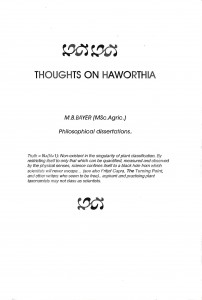Abstract:
This presentation is to show that life is an everchanging mosaic (just like species), and if you are cast into the role of speaker at 2 weeks notice it may give you some problems.
Presentation:
The first title for my talk (i.e. Enigma N-1) was the “The Haworthiod rocks of the Liliaceae”. This is based on what I thought my talk should be about, in terms of what the organisers would expect me to talk about, in terms of what the organisers would expect me to talk about. It is what I might have talked about had I indicated my intention of attending the congress when it was mooted as far back as 1996. I had no intention of being here, but by witchcraft or scientific prediction, I knew I would be.
Therefore I have a dilemma. I have good reason not to give the talk expected of me and hence why I did not intend presenting one. Therefore I have had to discover in my own mind, what are the pressures from within and without that bring me here.
I have come to know almost exactly what that pressure is through two weeks of blood, sweat and tears. I accumulated some material for talks, which I think you as delegates should see, but I have already written or edited 10 versions of a presentation.
When I spoke recently in the USA, I was not sure what title I had submitted to the convention organisers at Omaha. I asked Steven Hammer, and he said “Not to worry, the titles of talks tend to mutate”. The title of my talk was given as “Haworthia – why controversy”. I discovered in the 7 times I gave my talk, that it changed each time, but the title remained the same. My talk about Haworthia and controversy could have been either the words of Steven’s advice, or my submitted title. I discovered that both of them were equally relevant and apt.
In this case also I find I have given you a title for a talk and I would like to list other apt titles which I considered during preparation and after. The following titles were considered on material available to me:-
1. Haworthia why controversy.
2. Astroloba corrugata – name game?
The following titles were a result of active preparation:-
1. Another open letter
2. The real enigma in Haworthia
3. The haworthioid rocks of the Aspho Delay Sea
4. The haworthioid rocks of the Aspho Della Sea
5. Cabbages and Kings
6. Predictiveness in science
7. ICBN vs Larry C. Leach and Col. C.L. Scott
8. Does the ruling body of the ICBN know what it has done?
9. Do. plus cited literature
10. Do. plus cited literature and postscript
N + 1. Titles of talks mutate – N+1
N + 2. (The presentation as on 31st August – unwritten)
At this point I now know that I should not give my talk at all
My talk is that I have nothing to say.
I have realised that I can now write what I must say.
I know why the congress organisers have invited me – they are people I respect and admire – I cannot say no to them.
BUT
I feel that there is a distinct body of delegates who do not know who I am, why I am here nor what is expected of me by the organiser. I respect every one of those delegates too, known or unknown to me.
So I have come here to say nothing….BUT..PLEASE
SEE MY PAPER N + (N+1)

